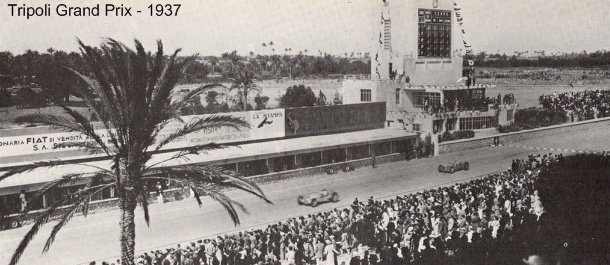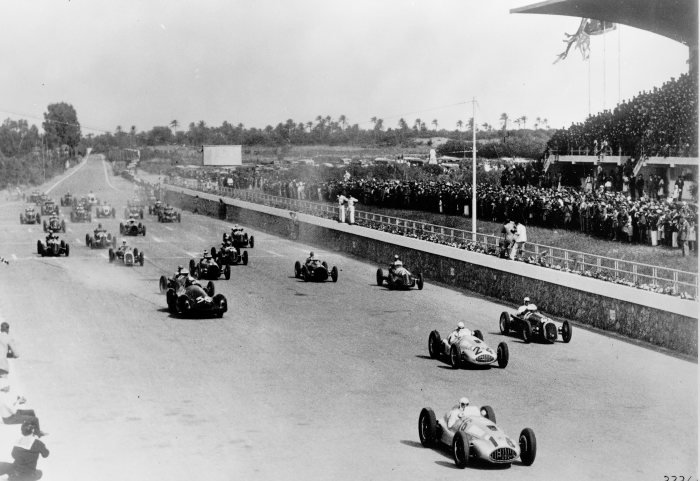The Italian Period: Mellaha Airfield and Tripoli Grand Prix
In 1911, after years of rule by the Ottoman Empire, the Italian Armed Forces invaded and took control of Tripolitania and Cyrenaica during the Italo-Turkish War of 1911-1912. In 1912, they consolidated the two provinces into a single state which they named ‘Italian Libya’1.
Chromolithograph depicting the outcome of the Italo-Turkish War (from the Italian Perspective)
MELLAHA AIRPORT
- Kodachrome of the Italian Airbase at Mellaha
In the years following their colonisation of Libya, the Italians commenced an impressive building programme in Tripolitania, bringing great architectural change and urban development to the region. During the early 1920’s the Italians expanded the railways inland from the port of Tripoli, introduced the first sewage system to the city of Tripoli, and a modern hospital 2.
it was during this period of great construction, in 1923, that Mellaha Airport was built as a military base for use by the Italian Air Force. Originally called ‘Aeroporto Militare di Mellaha’. It was situated 8km east of Tripoli’s city centre and rapidly grew in size and military importance. Regular air services, including aerospacial services to and from Libya began in November 1928, with the first Rome-Syracuse-Tripoli air route flying three times a week in winter and on a daily basis in summer, using planes from the "Societa Anonima Navigazione Aerea (SANA)", once a popular Italian airline based in Genoa and flying the popular Mediterranean routes3.

tripoli grand prix
Tripoli Grand Prix, 1937
MELLAHA RACETRACK
Italian dictator Benito Mussolini accorded the city of Tripoli particular importance as the center of the Italian colonies, having aspirations of developing a major empire equal to that of ancient Rome. Italian success in car racing in the 1920s was perceived as a symbol of Italian supremacy. and was viewed as an accomplishment to be promoted. Accordingly, the Italians built the first Libyan racing circuit at Mellaha in 1923. The first racing event occured in 1925 but due to the slow and uninspiring features of the track, these early races did not garner much international attention4.
1.2 D - Autodromo di Mellaha, Aerial of Mellaha Racing Track
TRIPOLI GRAND PRIX
In 1933, Mussolini, with encouragement from Libya’s new Fascist Governor-General, Itali Balbo, announced that the Tripoli Grand Prix should become a major international event. The administration set about creating the fastest track in the world, built around the Mellaha Salt Lake. It was 8.14 miles in length and consisted of a combination of curves and fast straights in an overall rectangular circuit.
Gran Premio Tripoli, 1934
Mellaha Racetrack Grandstand
Results for the Tripoli Grand Prix from 1933 - 1940
Year - Winner - Vehicle - Speed Mph
1933, Achille Varzi, Bugatti T51, 105.086
1934, Achille Varzi, Alfa Romeo Tipo-B "P3", 116.024
1935, Rudolf Caracciola, Mercedes-Benz W25B, 123.406
1936, Achille Varzi, Auto Union C, 129.412
1937, Hermann Lang, Mercedes-Benz W125, 132.440
1938, Hermann Lang, Mercedes-Benz W154, 127.840
1939, Hermann Lang, Mercedes-Benz W165, 123.291
1940, Giuseppe Farina, Alfa Romeo 158, 128.611 **
For the racers and audience there was also an impressive grandstand, furnished with mahogany seating, as well as well designed pit garages for car stops and a white control tower. The new Tripoli Grand Prix circuit, officially known as the ‘Circuito di Mellaha’ (the Tripoli Circuit) was inaugurated with the first racing event taking place in 19335.
At the time, the circuit was the fastest in operation and the pinnacle of race tracks of the era: the fastest race lap was recorded in 1937 at 142.877mph6.
The Tripoli Grand Prix continued at Mellaha until 1940, when, due to WW2, the event ceased. The beautiful grandstand and the circuit were both demolished in 1953 by the U.S Corps of Engineers.

TRIPOLI GRAND PRIX, 1939
FOOTNOTES
- Wikimedia Foundation. (2022, January 6). Italian invasion of Libya. Wikipedia. Retrieved February 13, 2022, from https://en.wikipedia.org/wiki/Italian_invasion_of_Libya.
- Fuller, M. (2014, June 3). Preservation and self-absorption: Italian colonisation and the walled city of Tripoli, Libya. The Journal of North African Studies. Retrieved February 13, 2022, from https://www.academia.edu/331701/Preservation_and_Self_Absorption_Italian_Colonisation_and_the_Walled_City_of_Tripoli_Libya.
- Crevato-Selvaggi, B. (2014, June 3). Le poste italiane fuori d'Italia. in Le Poste in Italia, 3. Tra le due guerre 1919-1945, a cura di Andrea Giuntini, Roma-Bari, Laterza, 2007 (Le Poste in Italia, opera diretta da Valerio Castronovo), pp. 243-272. Retrieved February 13, 2022, from http://www.academia.edu/2326842/Le_Poste_italiane_fuori_d_Italia.
- Grandprix.com. (n.d.). Mellaha, Libya. Latest Formula 1 Breaking News - Grandprix.com. Retrieved February 13, 2022, from https://www.grandprix.com/circuits/mellaha-libya.html.
- ibid.,
- 1937 Tripoli Grand Prix: Motorsport Database. Motorsport Database - Motor Sport Magazine. (2021, August 12). Retrieved February 13, 2022, from https://www.motorsportmagazine.com/database/races/1937-tripoli-grand-prix/.
- Liesemeijer, H., & By. (2019, April 25). Tripoli circuit - the history of Circuito di Mellaha. Circuits of the past. Retrieved February 13, 2022, from https://www.circuitsofthepast.com/tripoli-circuit/.
- Mellaha Lake. Mellaha Lake Track Info. (n.d.). Retrieved February 13, 2022, from http://www.silhouet.com/motorsport/tracks/mellaha.html.




